Inscriptions and Images in Secular Buildings : Examples from Renaissance Scania, Sweden, ca. 1450–1658
This paper examines how agents inscribed their persona in buildings during the Renaissance in Scania in present-day Sweden. Through an analysis of stone tablets and timber beams with inscriptions, images, and dates, questions of identity and individuality are highlighted. The objects were often placed above doors in noble country residences or in buildings belonging to the urban elite. The paper d
